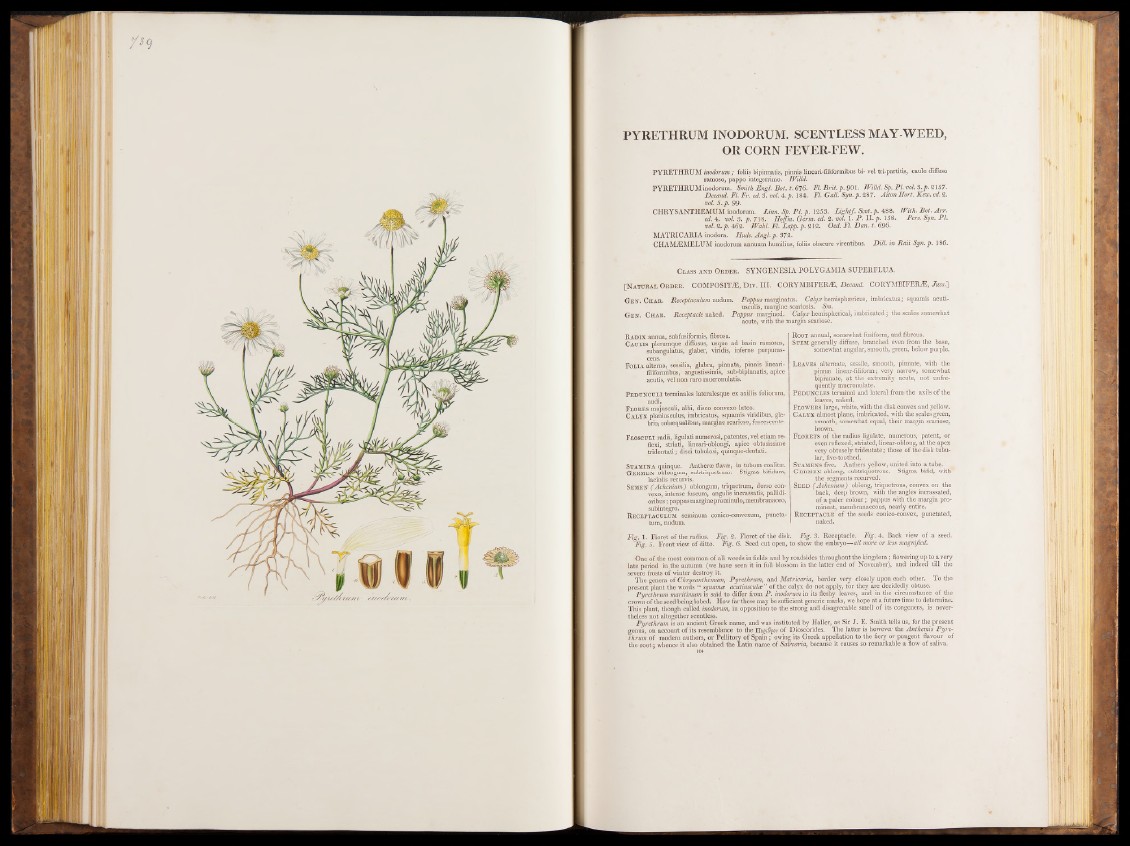
PYRETHRUM INODORUM. SCENTLESS MAY-WEED,
OR CORN FEVERFEW.
PY R E TH RUM inodorum ; foliis bipinnatis, pinnis lineari-filiformibus bi- vel tri-partitis, caule diffuso
ramoso, pappo integerrimo. JVilld.
PY RE TH RUM inodorum. Smith Engl. Bot. t. 676. Fl. B r it. p . 901. JVilld. Sp. PI. m l. 3. p. 2157.
Decand. F l Fr. ed. 3. ml. 4s.p. 184. F l G a ll Syn. p. 287. Alton Hort. Kero. ed. 2.
ml. 5. p . 99.
CHRYSANTHEMUM inodorum. Linn. Sp. PI. p . 1253. L ig h tf. Scot. p. 488. JVith. Bot. A rr.
ed. 4. ml. 3. p. 718. Hoffm. Germ. ed. 2. m l. 1. P . I I . p. 158. Pers. Syn. P I
ml. 2. p. 462. Wahl. Fl. Lapp.p. 212. Oed. Fl. Dan. t. 696.
MATRICARIA inodora. Huds. A ngl. p. 372.
CHAMiEMELUM inodorum annuum humilius, foliis obscure virentibus. Dill, in R aii Syn. p . 186.
Class a n d Order. SY N G EN E S IA POLYGAMIA SUPE E FLUA.
[N atural Order. C OM PO S IT E , D iv . I I I . CORYMBIFER.®, Decand. CORYMBIFERiE, Jiiw.]
Gen . Char. Receptaculum nudum. Pappus marginatus. Calyx hemisphasricus, imbricatus; squamis acuti-
usculis, margine scariosis. Sm.
Gen . Char. Receptacle naked. Pappus margined. Calyx hemispherical, imbricated; the scales somewhat
acute, with the margin scariose.
Radix annua, subfusiformis, fibrosa.
Caulis pleruraque diffusus, usque ad basin ramosus,
subangulatus, glaber, viridis, inferne purpuras-
Folia alterna, sessilia, glabra, pinnata, pinnis lineari-
filiformibus, angustissimis, sub-bipinnatis, apice
acutis, vel non raro mucronulatis.
PEDUNCULI terminales lateralesque ex axillis foliorum,
nudi.
Flores majusculi, albi, disco convexo luteo.
Calyx planiusculus, imbricatus, squamis viridibus, gla-
bris, subsequalibus, margine scarioso, fuscescente.
FLOSCULI radii, ligulati numerosi, patentes, vel etiam re-
flexi, striati, lineari-oblongi, apice obtusissime
tridentati; disci tubulosi, quinque-dentati.
Stamina quinque. Anthene flavte, in tubum coalitas.
Germen oblongum, subtriquetrum. Stigma bifidum,
laciniis recurvis.
Semen ( Achenium) oblongum, triquetrum, dorso convexo,
intense fuscum, angulis incrassatis, pallidi-
oribus; pappus margine prominulo, membranaceo,
subintegro.
Receptaculum seminum conico-convexum, puncta-
tum, nudum.
Root annual, somewhat fusiform, and fibrous.
Stem generally diffuse, branched even from the base,
somewhat angular, smooth, green, below purple.
Leaves alternate, sessile, smooth, pinnate, with the
pinnae linear-filiform; very narrow, somewhat
bipinnate, at the extremity acute, not unfre-
quently mucronulate.
Peduncles terminal and lateral from the axils o f the
leaves, naked.
Flowers large, white, with the disk convex and yellow.
Calyx almost plane, imbricated, with the scales green,
smooth, somewhat equal, their margin scariose,
brown.
Florets of the radius ligulate, numerous, patent, or
even reflexed, striated, linear-oblong, at the apex
very obtusely tridentate; those of the disk tubular,
five-toothed.
Stamens five. Anthers yellow, united into a tube.
Germen oblong, subtriquetrous. Stigma bifid, with
the segments recurved.
Seed ( Achenium) oblong, triquetrous, convex on the
back, deep brown, with the angles incrassated,
of a paler colour; pappus with the margin prominent,
membranaceous, nearly entire.
Receptacle of the seeds conico-convex, punctated,
naked.
Fig. 1. Floret of the radius. Fig. 2. Floret of the disk. Fig. 3. Receptacle. Fig. 4. Back view of a seed.
Lig. 5. Front view of ditto. Fig. 6. Seed cut open, to show the embryo—all more or less magnified.
One o f the most common of all weeds in fields and by roadsides throughout the kingdom; flowering up to a very
late period in the autumn (we have seen it in full blossom in the latter end of November), and indeed till the
severe frosts of winter destroy it.
The genera of Chrysanthemum, Pyrethrum, and Matricaria, border very closely upon each other. To the
present plant the words “ squama acutiusculee ” of the calyx do not apply, for they are decidedly obtuse.
Pyrethrum maritimum is said to differ from P . inodorum in its fleshy leaves, and in the circumstance of the
crown of the seed being lobed. How far these may be sufficient generic marks, we hope a t a future time to determine.
This plant, though called inodorum, in opposition to the strong and disagreeable smell of its congeners, is nevertheless
not altogether scentless.
Pyrethrum is an ancient Greek name, and was instituted by Haller, as Sir J . E. Smith tells us, for the present
genus, on account of its resemblance to the Ilufefyoi' of Dioscorides. The latter is however the Anthemis Pyre-
thrum o f modern authors, or Pellitory of S pain; owing its Greek appellation to the fiery or pungent flavour of
the ro o t; whence it also obtained the Latin name of Salvoaria, because it causes so remarkable a flow of saliva.
104